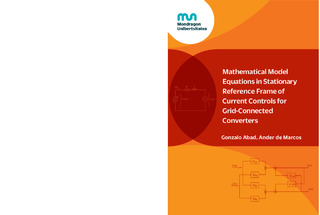| dc.rights.license | Attribution-NonCommercial-ShareAlike 4.0 International | * |
| dc.contributor.author | Abad, Gonzalo | |
| dc.contributor.author | Marcos Arocena, Ander de | |
| dc.date.accessioned | 2019-11-12T10:49:41Z | |
| dc.date.available | 2019-11-12T10:49:41Z | |
| dc.date.issued | 2019 | |
| dc.identifier.isbn | 978-84-09-15729-7 | en |
| dc.identifier.other | https://katalogoa.mondragon.edu/janium-bin/janium_login_opac.pl?find&ficha_no=153544 | |
| dc.identifier.uri | https://hdl.handle.net/20.500.11984/1492 | |
| dc.description.abstract | The grid-connected converter is a key element in many power electronic applications and technological devices which are commonly used nowadays. Wind turbines, photovoltaic generation, railway traction and grid-connected battery charges, are only some few examples of technological devices which incorporate grid-connected converters. In addition, one aspect within grid-connected converter is the current control.
Current controls of grid-connected converters is one element of vital importance as well. Thus, this book theorizes around two specific current controls of three phase grid connected converters. Current control of three phase grid-connected converters, can be made in a stationary reference frame, or often called also as αβ reference frame.
Alternatively also and probably more extended in industry, current control can be made in a synchronous rotating reference frame, or often called also as dq reference frame.
Therefore, this book develops the mathematical equations describing the behavior of the controlled currents in a stationary reference frame (αβ) of three phase converters. These mathematical expressions in αβ frame are derived, for the following well known and already well stablished current controls: current control with resonant controllers in stationary reference frame (αβ) and also, for current control with PI controllers in synchronous rotating reference frame (dq). Although these mathematical equations are already developed and quite commonly used for current controls in αβ frame, it is not easy to find them for current controls in dq frame, if they exist.
Moreover, it is important to highlight that the mathematical equations derived in this book, are expressed in ‘s’ domain after applying the Laplace transformation. This fact allows employing all the classic control theory tools, such as: pole-zero maps, frequency domain analysis, time domain responses to different inputs, etc… In addition, thanks to the knowledge of these mathematical equations in a common mathematical framework (αβ), it is possible to for instance: compare both current control methods at the same reference frame, easing comparative analyses.
Thus, after deriving the mathematical equations of the mentioned current controls, these equations are experimentally validated in a laboratory set-up. Finally, the last two chapters of the book introduce further analysis such as: effect of delays and performance of the current controls in weak grids. To conclude, the appendix summarizes the most important mathematical developments to derive some useful expressions. | en |
| dc.format.extent | 118 | en |
| dc.language.iso | eng | en |
| dc.publisher | Mondragon Unibertsitateko Zerbitzu Editoriala | en |
| dc.rights | © Los autores | en |
| dc.rights.uri | http://creativecommons.org/licenses/by-nc-sa/4.0/ | * |
| dc.title | Mathematical Model Equations in Stationary Reference Frame of Current Controls for Grid-Connected Converters | en |
| dc.type | http://purl.org/coar/resource_type/c_2f33 | |
| dcterms.accessRights | http://purl.org/coar/access_right/c_abf2 | en |
| local.contributor.department | Departamento de Electrónica e Informática | es |
| local.description.peerreviewed | false | en |
| local.identifier.doi | https://doi.org/10.48764/ET0S-M922 | |
| oaire.format.mimetype | application/pdf | |
| oaire.file | $DSPACE\assetstore | |
| oaire.resourceType | http://purl.org/coar/resource_type/c_2f33 | en |








